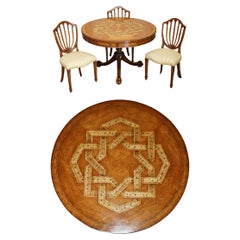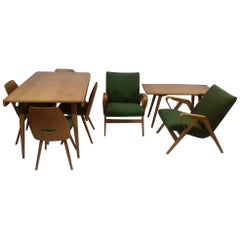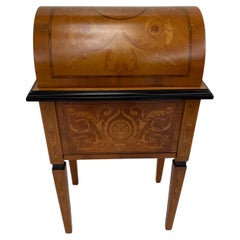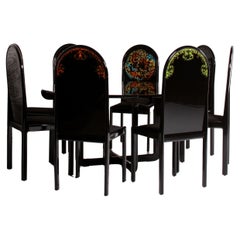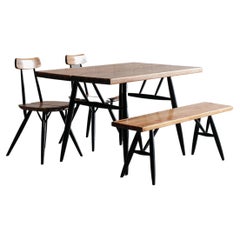European Dining Room Sets
to
114
Height
to
Width
to
Depth
to
511
151
577
106
17
247
64
48
45
15
8
7
6
4
4
3
3
3
2
2
2
1
6
44
527
123
45
284
140
4
3
15
26
20
62
88
87
25
6
528
238
128
124
109
700
318
297
206
112
700
609
640
25
15
9
8
8
Place of Origin: European
ViNTAGE CELTIC DESIGN BURR OAK & WALNUT DINING OCCASIONAL GAMES TABLE & CHAIRS
By George Hepplewhite
Located in West Sussex, Pulborough
Royal House Antiques
Royal House Antiques is delighted to offer for sale this exquisitely designed, hand made in England occasional dining table with Celtic design top and three Geo...
Category
20th Century Mid-Century Modern European Dining Room Sets
Materials
Oak, Walnut
Ate Van Apeldoorn Dinning Room Set
Located in Los Angeles, CA
This Ate Van Apeldoorn dining room set, comprising a table, three chairs, and three stools with leather seats, exudes the quintessential charm of 1960s Dutch d...
Category
1960s Vintage European Dining Room Sets
Materials
Leather, Wood
Set of Retro Furniture, Tatra Pravenec, 1960s
By Tatra Pravenec
Located in Praha, CZ
- Four dining chairs, two armchairs, adjustable dining table, coffee table
- Dimension of chairs: 78 x 42 x 43, dining table: 78 x 120-170 x 80, coffee table: 58 x 105 x 50
- Made ...
Category
1960s Mid-Century Modern Vintage European Dining Room Sets
Materials
Fabric, Wood
$4,633 / set
Art Nouveau Bar for sale in wood
By Mice di rugiano domenico e c. s.n.c.
Located in Cantù, IT
Art Nouveau Bar for sale in wood Private Collection
Category
1970s American Craftsman Vintage European Dining Room Sets
Materials
Wood
Björn Wiinblad for Rosenthal limited art series dining room set table & 8 chairs
By Bjorn Wiinblad
Located in Landshut, BY
THE FOUR CARDINAL POINTS
Rosenthal Kunstmöbelreihe
This noteworthy design is the work of Bjørn Wiinblad.
The furniture pieces were produced in a limited edition of 300 in 1976.
E...
Category
1970s Space Age Vintage European Dining Room Sets
Materials
Wood, Beech, Bentwood, Lacquer
Dining Room Set by Ilmari Tapiovaara for Laukaan Puu, 1950s, wood
By Laukaan Puu, Ilmari Tapiovaara
Located in Boom, Vlaams Gewest
Rare dining set with table, bench and 2 chairs.
Dinning room set By Ilmari Tapio vaara, designed in the 1950ties. This set is in good vintage condition.
Dimensions:
Table : 12...
Category
Mid-20th Century Mid-Century Modern European Dining Room Sets
Materials
Wood
Sheraton Style Mahogany Swing Leg Dining Room Table with Four Chairs
By Sheraton Revival
Located in Savannah, GA
This unique Sheraton style mahogany dining table features swing legs which is perfect in case you need more space at times and features fluted legs with brass castors. Four handsome ...
Category
1920s Sheraton Vintage European Dining Room Sets
Materials
Fabric, Mahogany
Brutalist Rustic Modern Dining Set in Stained Oak, Spain, 1970s
Located in Antwerp, BE
This Alpine dining set captures the rustic charm and refined craftsmanship synonymous with the Alps. Comprising a solid wood dining table and matching chairs, each piece exudes the r...
Category
Late 20th Century Brutalist European Dining Room Sets
Materials
Oak
Scandinavian Dining Room Set by Ilmari Tapiovaara 1950s Swedish Design F274
By Laukaan Puu, Ilmari Tapiovaara
Located in Ternay, Auvergne-Rhône-Alpes
Beautiful Scandinavian dining room set by Finnish designer Ilmani Tapiovaara from the 1950s for Laukaan Puu. It is composed of a dining table and four chairs model "Pikka". The struc...
Category
1950s Mid-Century Modern Vintage European Dining Room Sets
Materials
Pine
Mobichalet Brutalist Table with Chair and Stool in Oak
By Mobichalet
Located in Waalwijk, NL
Mobichalet, set of table, chair, and stool, oak, beech, Belgium, 1950s
This rustic set will come forward nicely in a relaxing atmosphere, like a patio or a studio space. The brutali...
Category
1950s Brutalist Vintage European Dining Room Sets
Materials
Beech, Oak
Moorish Style Dining Room Set with Colorful Tile-Top
Located in Isle Sur La Sorgue, Vaucluse
Oriental style dining room set. The table legs and top surround are carved with geometrical motifs. Lovely, bright ceramic tiled top, i...
Category
20th Century European Dining Room Sets
Inlaid Salon Set by Dassi Mobili Moderni, 1950s, Set of 12
Located in Montelabbate, PU
Inlaid Salon Set by Vittorio Dassi and Piero Del Grande for Dassi Mobili Moderni, 1950s – Set of 12
An exceptional and extremely rare salon set design...
Category
1950s Art Deco Vintage European Dining Room Sets
Materials
Rosewood
Gordon Russell. Designer WH Russell a Rosewood & Mahogany 'Burford' Dining Suite
By Gordon Russell, W. H. Russell
Located in London, GB
Gordon Russell Broadway. Designed by W.H. Russell FSIA. A rosewood and mahogany 'Burford' dining suite, comprising of a low side board, with serpentine ...
Category
1960s Mid-Century Modern Vintage European Dining Room Sets
Materials
Mahogany, Rosewood
Vintage Brutalist Oak Dining Set, Extension Table and 6 Chairs
By Guillerme et Chambron
Located in Lutz, FL
Vintage Oak Brutalist Dining Set circa 1970’s, in the style of Guillerme et Chambron, Maker Unknown. Purchased by original owner in Mainz-Kastel Germany in the 1970’s during his depl...
Category
Mid-20th Century Brutalist European Dining Room Sets
Materials
Oak
Børge Mogensen Set of Six Armchairs & Angelo Mangiarotti Eros Dining Table
By Børge Mogensen, Fredericia, Angelo Mangiarotti, Skipper
Located in Waalwijk, NL
Dining room set containing Børge Mogensen for Fredericia Stolefabrik set of six dining chairs with Angelo Mangiarotti for Skipper 'Eros' dining table
Børge Mogensen for Fredericia ...
Category
Mid-20th Century Mid-Century Modern European Dining Room Sets
Materials
Carrara Marble, Brass
1960s Dining Suite including Poul Kjaerholm PK54 Table & Mira Nakashima Chairs
By Mira Nakashima, E. Kold Christensen, Poul Kjærholm
Located in Stockholm, SE
An assembled Mid-Century dining set including a Danish dining table designed by Poul Kjærholm and a set of American dining chairs made by Mira Nakashima. The iconic round PK54 table ...
Category
1960s Mid-Century Modern Vintage European Dining Room Sets
Materials
Marble, Steel
Stunning Vintage Maple & Glass Top French Style Round Dining Table and 8 Chairs
Located in Hopewell, NJ
Lovely carved maple Louis XVI style French dining set having octagonal table base topped with 60" bevelled glass top. Legs are elegant cabriole w...
Category
1970s Louis XVI Vintage European Dining Room Sets
Materials
Fabric, Glass, Maple
$4,740 Sale Price
40% Off
Dining Table and Six Chairs
Located in Isle Sur La Sorgue, Vaucluse
Beautifully crafted dining table and six chairs with rush seats and backs. Very well assembled. The table has a thick slab top with a soft, rounde...
Category
1950s Mid-Century Modern Vintage European Dining Room Sets
Materials
Wood
$21,383 / set
Very Rare Gaetano Pesce Dining Set, Sansone 1 Table & 6x Dalila Chairs
By Cassina, Gaetano Pesce
Located in Aachen, NW
Very rare dining room set by Gaetano Pesce featuring 6x chairs model Dalila and a table model Sansone I.
Made by Polyurethane and urethane resin, pre -...
Category
1980s Vintage European Dining Room Sets
Materials
Resin
Regency period Mahogany triple pedestal dining table.
Located in Brighton, Sussex
A very imposing and good quality Regency period Mahogany triple pedestal dining table, with two extra leaves, having this wonderful figur...
Category
Early 19th Century Antique European Dining Room Sets
Materials
Mahogany
Italian Avant Garde Art Deco Style Dining Room Set
Located in Vero Beach, FL
Italian Avant Garde Art Deco Style Dining Room Set
Exceptional, rare, Italian avant garde Art Deco style dining room set. It was created by an extraor...
Category
Late 20th Century Art Deco European Dining Room Sets
Materials
Birdseye Maple, Ebony
$14,500 / set
Giorgio Collection Brazilian Rosewood Dining Table in Satin Finish
By Giorgio Collection
Located in New York, NY
Rectangular table in Brazilian rosewood satin finish with Italian walnut inlay top with 2 extension of cm. 48 (19”) each.
Brushed steel accents on the base.
Art Deco
Size 78’’ ½ W ...
Category
21st Century and Contemporary Art Deco European Dining Room Sets
Materials
Stainless Steel
Rudi Verelst Dining Table and Swivel Chair Set for Novalux
By Rudi Verelst
Located in Sint-Niklaas, VOV
Rare "Delta" set by belgian designer Rudi Verelst for Novalux Belgium produced in the 70s.
Set composed of 4 tubular chairs in White/red Agape Boucle fabric by Aristide as well as a...
Category
1970s Vintage European Dining Room Sets
Materials
Metal
Set of Iconic Gerd Lange 'Flex 2000' Chairs and Table for Thonet 1973
By Gerd Lange, Thonet
Located in Tilburg, NL
Set Iconic Gerd Lange 'Flex 2000' Chairs and table in Beech and Plastic for Thonet 1973.
This is a set of highly sculptural and avant garde quality by designer Gerd Lange for Thonet...
Category
Mid-20th Century Post-Modern European Dining Room Sets
Materials
Plastic, Beech
Suite exceptionnelle d’une grande table rectangulaire et de 4 chaises brutaliste
Located in BESANÇON, FR
Ensemble exceptionnel de salle-à-manger composé d’une grande table à manger rectangulaire vintage des années 60 70, en bois de chêne massif, dans le goût de Charlotte Perriand, Pierr...
Category
1960s Mid-Century Modern Vintage European Dining Room Sets
Materials
Wood
Set of 10 Dining Chairs by Vestergaard Jensen for Peder Pedersen
By Peder Pedersen, Helge Vestergaard-Jensen
Located in Sagaponack, NY
A rare and beautiful set of 8 sculptural rosewood dining chairs retaining their original black leather; there are six side and two armchairs in the set. Designed by Helge Vestergaard...
Category
1950s Mid-Century Modern Vintage European Dining Room Sets
Materials
Leather, Rosewood
Osvaldo Borsani Italian Mahogany Ebonized Dining Table, circa 1950
By Osvaldo Borsani
Located in Rovereta, Repubblica di San Marino
A beautifully ebonized mahogany and rose marble dining table by Arredamenti Borsani Varedo,whit original label, Italy, circa 1950. The wonderf...
Category
Mid-20th Century Mid-Century Modern European Dining Room Sets
Materials
Wood
Restored Art Deco Dinig Set, Caucasian Walnut, Thuja, Polished, England, 1920s
Located in Brandys nad Labem, Středočeský kraj
Introducing a truly unique and magnificent British Art Deco dining set from the 1920s, an embodiment of luxury and timeless elegance. This set, meticulously restored to a shellac pol...
Category
1920s Art Deco Vintage European Dining Room Sets
Materials
Fabric, Upholstery, Walnut, Lacquer, Wood
Dining Set for 3 People, 1970, Set of 4
Located in Montelabbate, PU
A solution for upper middle-class furnishing, with effect and impact. Visible quality and elegance of design. The set for three persons consists of: a table H 48 cm x diameter 119 cm...
Category
1970s Vintage European Dining Room Sets
Materials
Steel
$2,375 / set
Giorgio Collection Rectangular Crotch and Sapele Mahogany Wood Dining Table
By Giorgio Collection
Located in New York, NY
Boat-shape rectangular table with two extension leaves.
Top with combination of crotch mahogany and straight sapele mahogany.
Brushed steel details on the base.
Open table: 112” L x ...
Category
21st Century and Contemporary Art Deco European Dining Room Sets
Materials
Mahogany
Dining Table Set by Pierre Cardin for Roche Bobois, 1970s, Set of 6
By Roche Bobois
Located in Montelabbate, PU
Dining room set by Pierre Cardin for Roche Bobois, 1970s. Black lacquered wood set consisting of four chairs, a table and a sideboard. The table has an extendable glass top (extensio...
Category
1970s Modern Vintage European Dining Room Sets
Materials
Glass, Wood, Lacquer
$5,939 Sale Price / set
33% Off
Rainer Daumiller for Hirtshals Savværk A/S dining set - Denmark, 1970s
By Rainer Daumiller
Located in Linkebeek, BE
Rainer Daumiller for Hirtshals Savværk A/S dining set - Denmark, 1970s
Wear consistent with age and use
Mid-century Modern - Vintage - Funiture
Dining Set : Table - 2 Chairs - 1 st...
Category
1970s Mid-Century Modern Vintage European Dining Room Sets
Materials
Wood
Set of Wrought Iron Dining Table and Armchairs, Garden or Patio Furniture
Located in Miami, FL
Set of dining table and armchairs. Garden or patio furniture. Indoor and outdoor
Includes:
1 round white creamtable with werzalit top ( very resistant for outdoor)
Top 35.43in d...
Category
2010s Country European Dining Room Sets
Materials
Iron
Dinning room set by Tecno and Eugenio Gerli
By Tecno, Eugenio Gerli
Located in grand Lancy, CH
set of 6 chairs in teak, white leather, metal and a table in aluminum steel and walnut the legs of the table are in gold metal the table has a slightly darker mark in the center of t...
Category
1960s Vintage European Dining Room Sets
Materials
Aluminum, Steel
$7,800 / set
Set Of 5 Corian Steel Dining Table And Seating by Pol Quadens
Located in Geneve, CH
Set Of 5 Corian Steel Dining Table And Seating by Pol Quadens
Limited Edition Of 8+4 Pieces.
Dimensions: D 76 x W 250 x H 74 cm.
Materials: Lacquered steel.
Pol Quadens was born in...
Category
2010s Post-Modern European Dining Room Sets
Materials
Steel
Dining set, table + 6 chairs, Northern Europe, ca. 1930.
Located in Chorzów, PL
Dining set, table + 12 chairs, Northern Europe, ca. 1930.
Very good condition, after professional renovation and replacement of upholstery with new leather.
Wood: oak
Dimensions:
...
Category
Early 20th Century Renaissance Revival European Dining Room Sets
Materials
Leather, Wood, Oak
Kindel Furniture Cherrywood & Hand Painted Giltwood Extendable Dining Table
By Kindel Furniture
Located in Pulborough, GB
We are delighted to offer for sale this Kindel furniture cherrywood gold giltwood dining table.
This table is vintage 1950s, an extendable table with three extra boards, so you ch...
Category
20th Century Mid-Century Modern European Dining Room Sets
Materials
Cherry
Carlo Scarpa Cognac Leather “Kentucky” Dining Chair for Bernini, 1977, Set of 5
By Bernini, Carlo Scarpa
Located in Vicenza, IT
Set of 5 mod. 783 “Kentucky” dining chairs, designed by Carlo Scarpa for the Italian manufacturer Bernini in 1977.
Structure made from oak and walnut timber.
Seats and backrest made from cognac leather.
Excellent vintage condition.
Carlo Scarpa designed this chair for the “Scuderia” series., the last project he made for Bernini.
The architect took inspiration from the “shaker” movement.
He designed the chair slightly inclined at the front. This feature allows you to swing backward (until you lean on a wall) and remain in balance.
Born in Venice on June 2nd, 1906, Carlo Scarpa began working at a very early age. A year after he had first qualified as an architect in 1926, he began working for the Murano glassmakers Cappellin & Co. in a consultative capacity. From 1927, Carlo Scarpa began to experiment with the Murano glass, and this research not only gave him excellent results here but would also inform his progress for many years to come. Between 1935 and 1937, as he entered his thirties, Carlo Scarpa accepted his first important commission, the renovation of Venice’s Cà Foscari. He adapted the spaces of this stately University building that stands on the Grand Canal banks, creating rooms for the Dean’s offices and a new hall for academic ceremonies; Mario Sironi and Mario De Luigi were charged with doing the restoration work on the frescos. After 1945, Carlo Scarpa found himself constantly busy with new commissions, including various furnishings and designs for the renovation of Venice’s Hotel Bauer and designing a tall building in Padua and a residential area in Feltre, all worth mentioning. One of his key works, despite its relatively modest diminished proportions, was the [bookshop known as the] Padiglione del Libro, which stands in Venice’s Giardini di Castello and clearly shows Scarpa’s passion for the works of Frank Lloyd Wright. In the years which were to follow, after he had met the American architect, Scarpa repeated similar experiments on other occasions, as can be seen, in particular, in the sketches he drew up in 1953 for villa Zoppas in Conegliano, which show some of his most promising work. However, this work unfortunately never came to fruition. Carlo Scarpa later created three museum layouts to prove pivotal in terms of how twentieth-century museums were set up from then on. Between 1955 and 1957, he completed extension work on Treviso’s Gipsoteca Canoviana [the museum that houses Canova’s sculptures] in Possagno, taking a similar experimental approach to the one he used for the Venezuelan Pavilion at [Venice’s] Giardini di Castello which he was building at the same time (1954-56). In Possagno Carlo Scarpa was to create one of his most significant ever works, which inevitably bears comparison with two other museum layouts that he was working on over the same period, those of:
– Galleria Nazionale di Sicilia, housed in the Palazzo Abatellis in Palermo (1953-55)
– Castelvecchio in Verona (1957- 1974), all of which were highly acclaimed, adding to his growing fame.
Two other buildings, which are beautifully arranged in spatial terms, can be added to this long list of key works that were started and, in some cases, even completed during the nineteen fifties. After winning the Olivetti award for architecture in 1956, Scarpa began work in Venice’s Piazza San Marco on an area destined to house products made by the Industrial manufacturers Ivrea. Over the same period (1959-1963), he also worked on the renovation and restoration of the gardens and ground floor of the Fondazione Querini Stampalia in Venice, which many consider one of his greatest works. While he busied himself working on-site at the Fondazione Querini Stampalia, Carlo Scarpa also began work building a villa in Udine for the Veritti family. To shed some light on the extent to which his work evolved over the years, it may perhaps be useful to compare this work with that of his very last building, villa Ottolenghi Bardolino, which was near to completion at the time of his sudden death in 1978. Upon completion of villa Veritti over the next ten years, without ever letting up on his work on renovation and layouts, Scarpa accepted some highly challenging commissions, working on the Carlo Felice Theatre in Genoa and another theatre in Vicenza.
Towards the end of this decade, in 1969, Rina Brion commissioned Carlo Scarpa to build the Brion Mausoleum in San Vito d’Altivole (Treviso), a piece he continued to work on right up until the moment of his death. Nevertheless, even though he was totally absorbed by work on this mausoleum, there are plenty of other episodes which can offer some insight into the final years of his career. As work on the San Vito d’Altivole Mausoleum began to lessen from 1973, Carlo Scarpa started building the new headquarters for the Banca Popolare di Verona. He drew up plans that were surprisingly different from the work he was carrying out at the same time on the villa Ottolenghi. However, the plans Carlo Scarpa drew up, at different times, for a monument in Brescia’s Piazza della Loggia commemorating victims of the terrorist attack on May 28th, 1974, make a sharp contrast to the work he carried out in Verona, almost as if there is a certain hesitation after so many mannered excesses. The same Pietas that informs his designs for the Piazza Della Loggia can also be seen in the presence of the water that flows through the Brion Mausoleum, almost as if to give a concrete manifestation of pity in this twentieth-century work of art. Carlo Scarpa has put together a highly sophisticated collection of structures, occupying the mausoleum’s L-shaped space stretching across both sides of the old San Vito d’Altivole cemetery. A myriad of different forms and an equally large number of different pieces, all of which are separate and yet inextricably linked to form a chain that seems to offer no promise of continuity, rising up out of these are those whose only justification for being there is to bear the warning “si vis vitam, para mortem,” [if you wish to experience life prepare for death] as if to tell a tale that suggests the circle of time, joining together the commemoration of the dead with a celebration of life. At the entrance of the Brion Mausoleum stand the “propylaea” followed by a cloister which ends by a small chapel, with an arcosolium bearing the family sarcophagi, the main pavilion, held in place on broken cast iron supports, stands over a mirror-shaped stretch of water and occupies one end of the family’s burial space. The musical sound of the walkways teamed with the luminosity of these harmoniously blended spaces shows how, in keeping with his strong sense of vision, Carlo Scarpa could make the most of all of his many skills to come up with this truly magnificent space. As well as a great commitment to architectural work, with the many projects which we have already seen punctuating his career, Carlo Scarpa also made many equally important forays into the world of applied arts. Between 1926 and 1931, he worked for the Murano glassmakers Cappellin, later taking what he had learned with him when he went to work for the glassmakers Venini from 1933 until the 1950s. The story of how he came to work on furniture design is different, however, and began with the furniture he designed to replace lost furnishings during his renovation of Cà Foscari. The later mass-produced furniture started differently, given that many pieces were originally one-off designs “made to measure.” Industrial manufacturing using these designs as prototypes came into being thanks to the continuity afforded him by Dino Gavina, who, as well as this, also invited Carlo Scarpa to become president of the company Gavina SpA, later to become SIMON, a company Gavina founded eight years on, in partnership with Maria Simoncini (whose own name accounts for the choice of company name). Carlo Scarpa and Gavina forged a strong bond in 1968 as they began to put various models of his into production for Simon, such as the “Doge” table, which also formed the basis for the “Sarpi” and “Florian” tables. In the early seventies, other tables that followed included “Valmarana,” “Quatour,” and “Orseolo.” While in 1974, they added couch and armchair “Cornaro” to the collection and the “Toledo” bed...
Category
1970s Mid-Century Modern Vintage European Dining Room Sets
Materials
Walnut, Leather, Plastic
ViNTAGE ENGLISH HERITAGE PINE DINING TABLE & EIGHT WINSOR CHAIRS SUITE 8
Located in West Sussex, Pulborough
Royal House Antiques
Royal House Antiques is delighted to offer for sale this lovely vintage English Pine refectory dining table and eight Winsor chairs
Please note the delivery fe...
Category
20th Century Country European Dining Room Sets
Materials
Pine
Kaare Klint Dinning Table for Rud. Rasmussen
By Rud Rasmussen, Kaare Klint
Located in Copenhagen, DK
Kaare Klint dinning table in mahogany. Executed by Rud. Rasmussen.
Underside with manufacturer's paper label RUD. RASMUSSENS/SNEDKERIER/45 NØRREBROGAD/KØBENHAVN, pencilled serial nu...
Category
Mid-20th Century Scandinavian Modern European Dining Room Sets
Materials
Mahogany
1950s Bertha Schaefer Walnut Dining Set w/ Table & 5 Chairs
By M. Singer & Sons, Bertha Schaefer
Located in Philadelphia, PA
This is a handsome oiled-walnut dining set designed by Bertha Schaefer for M. Singer & Sons in 1952 and produced in Italy for the Singer Modern collection. The set includes a large o...
Category
1950s Modern Vintage European Dining Room Sets
Materials
Steel
French Mid-Century Modern Neoclassical Dining Table by Andre Arbus, Paris, 1949
By André Arbus
Located in New York, NY
An Elegant And Timeless French Late Art Deco / Modern Neoclassical dining room table in cherry by Andre Arbus. The table without leaves is 72" long....
Category
1940s Mid-Century Modern Vintage European Dining Room Sets
Materials
Brass
Round table with four chairs from the 1960s, Denmark.
Located in Chorzów, PL
A set of four dining chairs designed by Bernhard Pedersen & Son, manufactured in Denmark in the 1960s. The table comes from Denmark and was manufactured in the 1960s. The table has o...
Category
Mid-20th Century Scandinavian Modern European Dining Room Sets
Materials
Wood
Large and Round Marble Table with Feet in the Shape of Lions, Italy
Located in Brussels, BE
Large and round marble table with feet in the shape of lions, Italy.
Category
Mid-20th Century European Dining Room Sets
Materials
Marble
Post modern 6 Black Spaghetti dining chairs & table set by Giandomenico Belotti
By Giandomenico Belotti
Located in Brooklyn, NY
Original Spaghetti Patio chairs and matching rectangular table with reversible top in all Black by Giandomenico Belotti for Alias Made in Italy. Gorgeous Minimalist Italian design fr...
Category
1970s Post-Modern Vintage European Dining Room Sets
Materials
Steel
$4,400 Sale Price / set
20% Off
Rare dining set - Soren Nissen & Ebbe Gehl
By Ebenisterie Seltz et Fils 1
Located in Antwerpen, BE
A rare dining set by Søren Nissen & Ebbe Gehl for French Ebénisterie Seltz, a small family-run wood workshop. The set consists of 4 chairs and a dining table, manufactured in solid b...
Category
Mid-20th Century Mid-Century Modern European Dining Room Sets
Materials
Beech
Studio Tetrarck Design for Alberto Bazzani Italy in Years 1970 Set
By Studio Tetrarch
Located in Biella, IT
studio Tetrarck design for Alberto Bazzani Italy in years 1970 complete set of the one table and four chairs
original top glass of 0.6 inches tickness
table measue 48 inches diamet...
Category
1960s Modern Vintage European Dining Room Sets
Materials
Chrome
New Modern Dining Table in Travertine Navona, Creator Karen Chekerdjian
By Karen Chekerdjian
Located in Milan, IT
Karen Chekerdjian expands her iconic Inside Out collection with the new Large Dining Table—a bold yet essential centerpiece for contemporary interiors. This new iteration introduces ...
Category
2010s Modern European Dining Room Sets
Materials
Marble
Tablecloth by Davide Medri
Located in Geneve, CH
Tablecloth by Davide Medri
Materials: mirror mosaic (silver)
Also available in gold.
Dimensions: H 90 x D 120 cm
Davide Medri was born in Cesena on August 7th 1967 and graduated at ...
Category
2010s Modern European Dining Room Sets
Materials
Mirror
$7,997 / item
Set of Table and Six Chairs by S. Salvadori, Firenze, circa 1960
By S. Salvadori
Located in Paris, FR
Rare set of 1960s Italian table and six chairs with elaborately detailed backs, in the design of a sheaf of wheat. Raised on gorgeous slim legs with X-stretchers, Classic Italian gil...
Category
1960s Vintage European Dining Room Sets
Materials
Gold Leaf, Iron
Curved White Lacquered Classe Bar by Mowee
Located in Geneve, CH
Curved white Lacquered classe bar by Mowee
Dimensions: D 100 x W 100 x H 115 cm
Material: Polyethylene and stainless steel.
Weight: 31 kg
Also availabl...
Category
2010s Post-Modern European Dining Room Sets
Materials
Stainless Steel, Other
$4,288 / item
Dining Set by Goons
Located in Geneve, CH
Dining Set by Goons
Dimensions:
Table: W 130 x D 50 x H 74 cm
Chair: 35 x 40 x 95 cm
Materials: Wood.
Goons is located in Paris, France. All of their designs are made out of wood.
Category
2010s Post-Modern European Dining Room Sets
Materials
Wood
$22,856 / set
Midcentury Bamboo and Rattan Italian Foldable Table and Four Chairs, 1960s
Located in Roma, IT
Beautiful midcentury set, made of bamboo and rattan foldable table and four chairs. It is an Italian production of 1960s and the state of conserva...
Category
1960s Mid-Century Modern Vintage European Dining Room Sets
Materials
Bamboo, Rattan, Glass
Italian Midcentury Modern Mahogany and Rosewood Dining set, Osvaldo Borsani 1950
By Atelier Borsani Varedo, Osvaldo Borsani
Located in Ceglie Messapica, IT
Italian Midcentury Modern Mahogany and Rosewood Dining set, Osvaldo Borsani 1950
Export document needed only for extra EU
This exquisite Italian Midcentury Modern dining set, desi...
Category
1950s Mid-Century Modern Vintage European Dining Room Sets
Materials
Brass
$9,503 Sale Price / set
33% Off
Set of Four Mackintosh “309 Ingram” Mid Century Modern Dining Chairs by Cassina
By Charles Rennie Mackintosh, Cassina
Located in Dronten, NL
Exquisite set of 4 Charles Rennie Mackintosh “309 Ingram” dining chairs for Cassina in stained cherry and black leather.
The 309 Ingram dining chairs, designed by Charles Rennie Ma...
Category
Mid-20th Century Mid-Century Modern European Dining Room Sets
Materials
Leather, Cherry
Vintage Art Deco Burr Walnut Ornately Carved Dining Table and 6 Dining Chairs
Located in West Sussex, Pulborough
We are delighted to offer for sale this exquisite heavily carved Art Deco Burr Walnut dining table with six sculptural dining chairs
A beautiful example of this kind of work, the ...
Category
Early 20th Century Art Deco European Dining Room Sets
Materials
Walnut
"Big Iron" Chairs / "Running Gun" Table, Iron, James Vincent Milano, Italy, 2023
By JAMES VINCENT MILANO
Located in Milano, IT
“Big Iron/Running Gun” Dining Room Set, Iron, JAMES VINCENT MILANO, Italy, 2023
“Running Gun” Dining Table, Iron, JAMES VINCENT MILANO, Italy, 2023
Irregular hexagonal top. Tr...
Category
21st Century and Contemporary Brutalist European Dining Room Sets
Materials
Iron
Organic Modern Armona Dining Table, American Oak, Brass, Handmade by Greenapple
By Greenapple, Rute Martins
Located in Lisboa, PT
Organic Modern Armona Dining Table, Contemporary Collection, Handcrafted in Portugal - Europe by Greenapple.
The Armona dining table draws inspiration from the serene landscape of A...
Category
21st Century and Contemporary Organic Modern European Dining Room Sets
Materials
Brass
Super-Ellipse Model B613 By Piet Hein For Fritz Hansen
By Piet Hein, Fritz Hansen
Located in Lejre, DK
Super-Ellipse, Model B613, designed by Piet Hein, is an iconic table that combines functionality and aesthetics in a unique way. This table has a white laminate table top, which give...
Category
21st Century and Contemporary Mid-Century Modern European Dining Room Sets
Materials
Laminate
$1,896 Sale Price
20% Off
Sculptural Dining Set in Pine by Gilbert Marklund for Furusnickarn AB, 1970s
By Furusnickarn AB, Gilbert Marklund
Located in PRAHA 5, CZ
Designed by Gilbert Marklund for Furusnickarn AB, Sweden 1970s. Unique and durable, solid pine wood dining table in original condition. Exceptionally sturdy, showcasing impressive Sc...
Category
1970s Scandinavian Modern Vintage European Dining Room Sets
Materials
Pine
$2,608 Sale Price / set
40% Off
Recently Viewed
View AllMore Ways To Browse
Silver Dragon Teapot
Spode Gold Gilt
Staffordshire Couple
Stave Sylvia
Stephen Kenn Outdoor
Stereo Turntable
Sterling Baby Rattle
Sterling Bud Vase
Sterling Cake Basket
Sterling Pin Cushion
Sterling Silver Baby Rattle
Sterling Silver Cigar Lighter
Sterling Silver Entree
Sterling Silver Pheasants
Sterling Silver Table Animals
Stone Font
Straits Chinese Porcelain
Straw Marquetry Box
